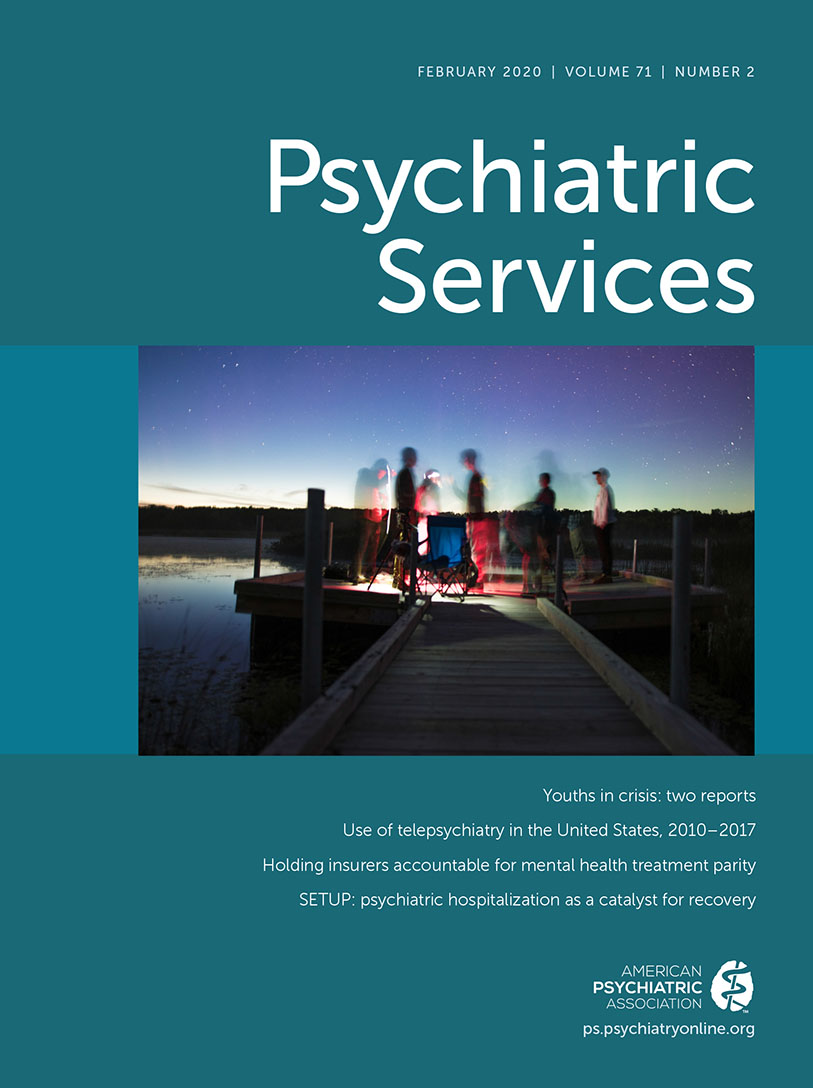There is little debate that the U.S. mental health care system is in dire need of delivery reform. The Centers for Disease Control and Prevention reported that suicide rates increased by 33% from 1999 to 2017, with the highest increase in rural counties, where suicide rates were nearly twice as high as rates in urban areas by 2017. In 2018, 115 million Americans lived in a mental health professional shortage area (
1), and according to the National Survey on Drug Use and Health, nearly one-quarter of adults with mental illness reported an unmet need for mental health treatment. The gap in mental health access is particularly wide for low-income individuals with Medicaid; in 2015, only about one-third of psychiatrists were accepting new Medicaid patients, compared with over 70% of primary care and other specialist physicians (
2).
One promising solution to bridge at least some of the gaps in access is telemedicine. Typically defined by payers such as Medicare and Medicaid as the use of communications technology for two-way real time interactive communication between patient and provider (42 CFR § 410.78), telemedicine is particularly well suited for the delivery of mental health care. Although a major limitation of telemedicine is the lack of opportunity for in-person contact, mental health diagnosis and therapy are generally conducted by interview without a physical examination. Also, the ease of accessing a provider at a nearby facility or even in the home can facilitate treatment initiation and engagement.
That behavioral health has emerged as one of the most common applications of telemedicine is unsurprising. A recent study among millions of privately insured enrollees from 2005 to 2017 found that the majority of telemedicine visits were for mental health, with over 50% annual compound growth in the number of tele–mental health service visits over more than a decade, although overall use rates were less than two visits per 1,000 enrollees annually (
3). However, among populations with serious mental illness, telemedicine use is much higher: one study found a rate of 12 visits per 100 Medicare beneficiaries with serious mental illness in 2014, with some more rural states, such as Nevada, having rates as high as 45 visits per 100 (
4). Each of these studies used insurance claims data to look at individual-level use of tele–mental health; however, there remains relatively little data on the “other side” of the visit—the offices and facilities where providers are based.
A new analysis by Spivak and colleagues (
5) makes a helpful contribution to the evidence on adoption of telemedicine in behavioral health. The authors used several years of a comprehensive national survey of mental health facilities administered by the Substance Abuse and Mental Health Services Administration (SAMHSA), the National Mental Health Services Survey (N-MHSS), to explore facility adoption of telemedicine. They performed a thorough descriptive analysis of the prevalence and characteristics of facilities offering telemedicine, defined in the N-MHSS instrument as “the ability for healthcare providers, working from a distance using telecommunications technology, to communicate with patients, diagnose conditions, [and] provide treatment.” Importantly, they linked several other data sets to the N-MHSS to provide richer detail on state-level characteristics and telemedicine policy, urban-rural geography, and medically underserved areas. They used unadjusted logistic regression to compare differences between facilities that offer and do not offer telemedicine, accounting for the clustering of outcomes between states.
The most striking finding is the rapid pace of adoption in mental health facilities; the percentage offering telemedicine nearly doubled, from 15% in 2010 to 29% in 2017. In many states, particularly in the Midwest and South, nearly half of or more mental health facilities offered telemedicine. These facilities differed in important ways from those not offering telemedicine. Telemedicine facilities were over twice as likely to be publicly owned (30.1% versus 13.7% of those not offering telemedicine) and were more likely to have funding from federal, Veterans Affairs, and local government sources. They also were more likely to be present in more heavily rural states and states with a higher proportion of underserved counties, although many facilities were also located in states with lower rural populations. These results suggest that tele–mental health is being adopted widely, but particularly so among public, likely safety-net facilities, located in areas with lower availability of mental health services.
There are important limitations to this analysis to consider in interpreting Spivak and colleagues’ results. The analysis of facility characteristics and telemedicine use is purely cross-sectional, so all associations have little to say about the causality of any given factor with telemedicine adoption. Also, there is no multivariate modeling of associations, so it is not clear which characteristics of facilities are independently associated with adoption in the presence of other shared factors. The data set used also gives no information on who telemedicine is used for or which telemedicine services are provided at these facilities, which is extremely important for guiding future policy.
Despite these limitations, there is little question that telemedicine has grown substantially across the mental health sector. What could be driving this? There are likely several factors at play. First, the need for new options in mental health delivery is vast. The mental health workforce is not growing fast enough to meet demand. Provider shortages are particularly acute in rural areas, where telemedicine is especially helpful given the large distances many patients need to travel to access care. Second, broadband Internet access is becoming increasingly ubiquitous, which has been a key bottleneck for implementing video-based telemedicine technology in rural areas (
6). Third, there is significant policy momentum toward covering telemedicine more broadly at the federal, state and insurer levels. The federal government has passed legislation to promote telemedicine adoption and remove regulatory and reimbursement barriers, including 2018’s SUPPORT Act (H.R. 6), which loosened Medicare’s restrictions on reimbursement for telemedicine services. States have been passing payment parity laws for telemedicine reimbursement, and Medicaid programs as well as private insurers have been expanding coverage for telemedicine services. We are in a period of rapid expansion and innovation in tele–mental health, although the prevalence of use is still low in the general population (
3).
The growth has important implications for the entire telemedicine industry and the health care system as a whole. One somewhat counterintuitive result is that innovation seems to be rooted most heavily in safety net and publicly funded institutions. The Veterans Health Administration (VHA), which has wholeheartedly embraced telemedicine for many years, is a good example of this. Public institutions such as VHA have likely taken the lead in tele–mental health because they have a mandate to serve populations in their region regardless of distance. Telemedicine is therefore one of the most obvious options to better extend workforces to serve more patients needing access, many of whom may be hours away by vehicle. This is a scenario where the private sector may have lessons to learn from the public sector in implementing telemedicine on a broader scale.
There is still much to learn about tele–mental health. Spivak and colleagues’ analysis provides strong motivation to continue research into the many unanswered questions in tele–mental health, including, how is it used in practice, including differences in rural versus urban settings? How much of the gap in mental health access is addressable through tele–mental health? What are the most effective approaches to implementing tele–mental health programs? How do patients feel about tele–mental health? Despite the range of facilities adopting tele–mental health, it is likely that only a fraction of the population who needs access most is receiving mental health services. Increasing acceptance of new modes of mental health delivery is an encouraging next step to improving access for all in need.

